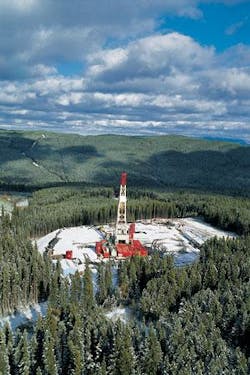What’s so "super"about independents?
While there is no clear-cut consensus on exactly how to define a “super independent,” the group of eight or so large independent oil and gas producers has attracted a lot of well-deserved attention in the press and among their peers in the petroleum industry. Like strapping teenage athletes, the firms have outgrown their former dimensions and are performing well but have not yet reached the rarified heights of the major integrated oil companies.
Whatever criteria one uses to define them, it is clear the Super Independents (for brevity, let’s call them “SIs”) as a group have positioned themselves well for further growth, and they will continue to be a source of fascination and envy.
Just who are the SIs and how did they earn the right to be called “Super?” Oil & Gas Financial Journal went to several industry analysts for their insight.
Any three sets of consultants, bankers, and oilmen will provide their own unique lists of SIs. However, the companies that show up on nearly all of them are: Anadarko Petroleum Corp., Apache Corp., Burlington Resources Inc., Devon Energy Corp., Occidental Petroleum Corp., and Unocal Corp. If you include non-US companies, add Calgary-based EnCana Corp. and UK-based BG Group to the mix.
Size and asset portfolio diversification are two criteria many apply. Jeff Hayden, an analyst with Dan Pickering Energy Partners, Houston, said proved reserves of at least two billion barrels of oil equivalent and market capitalization at $15 billion or higher, including some “meaningful international plays,” are ways he differentiates the SIs from the rest of the pack below the super-majors.
While SIs have bulked up considerably in terms of assets and cash in the recent run-up of oil and natural gas prices, there is still a considerable gap between the largest of the SIs (EnCana, with about $35 billion market capitalization) and a small major integrated petroleum company with about $70 billion in market-cap, Hayden emphasized.
“Super independents are doing things that the majors used to do,” said John Thieroff, New York City-based oil and gas analyst for Standard & Poor’s Ratings Services. “They are out in the frontier, deepwater areas - not just dabbling - but working side-by-side with the Chevrons, Exxons and Conocos. They are no longer just passive participants.”
Scratch non-E&Ps
For most of the observers who commented for this article, true independents have to be born that way, so they would scratch Marathon, Unocal, and Occidental, among others, from any listing of super independents. For the most part, the SIs have relied on acquisitions and organic growth over the years, buying up other independents in some instances. And mergers and acquisitions will continue, the analysts say. Exploration and production activity is the dominant area for SIs and integrated companies alike.
In 2004, almost across the board, the SI companies reported record earnings, led by Apache, Anadarko, Devon, and EnCana. The growth in E&P and control for costs-per-barrel-equivalent were such that the companies and their peers enhanced underlying value and bumped up per-share financial statistics. Each CEO seems to be trying to outdo the others with his personal brag-sheets quarterly.
“They’ve all done extremely well,” said David Pruner, a Houston-based vice president for consulting at Wood Mackenzie. “It is a case now where super independents have net income of over $1.5 billion, which is a lot of money in anybody’s book. The vast majority have reached that level. And the vast majority of the profits, for most of them, have been made domestically.”
Everyone has his or her favorites, depending on his or her perspective. Some stress financials, and others like to zero in on the relative strength of the strategies of these companies, many of which have come a long way in a short span of years. A common thread among the most successful is that some key part of each company focuses laser-like on North American oil and gas activities, the analysts and consultants say.
Generally, the SIs have used their growth wisely, accelerating the trip over the learning curve, so with each new acquisition and E&P play they approach challenges more astutely. This means lower costs and better well completions, according to Steve Enger, equity analyst and principal in the Denver office of Petrie Parkman & Co., who is a former Permian Basin petroleum engineer. This can mean moving from heavier, more formation-damaging gel-fracturings to lighter slip water treatment.
“The key when you are drilling hundreds, if not thousands of wells each year is that you really want to pay a lot of attention to that learning curve and continue to move on that learning curve,” Enger said.
While giving kudos to many of the usual suspects within the SI grouping, Derek Butter, Wood Mackenzie’s corporate research director in Edinburgh, Scotland, thinks Calgary, Alberta-based EnCana tops the class because of what he calls the company’s “fundamentally sound underlying strategy.” Being purely focused on North American oil and gas, and selling off assets “for a tidy profit” in the UK and Gulf of Mexico are major pluses, Butter said.
“They are purely focused on the North American natural gas market,” he said. “And they are going to be spending $22 billion over the next four years in North America exclusively to develop gas resources while wholesale gas prices are very high.”
“Their investment plans in the region are bigger than those of the super-majors. EnCana is going to be the largest spender in North America, along with becoming the largest gas producer. You can now almost categorize EnCana as a sort of ‘North American super-major,’ if you like.”
Investors watching
It is this sort of positive spin that is attracting increasing attention from the investment community at a time when the entire petroleum sector has captured its overall attention. A lot of the general interest is based on current conventional wisdom that most projects’ present historically high global energy prices will stay high for at least the next two years, if not longer.
“Since they are [for the most part] not involved in refining, SIs are seen as more of a pure play on the commodity prices,” said Hayden, of the Dan Pickering group. “As the super independents are the most liquid stocks in the sector (aside from the majors), large mutual funds will need to have core positions to maintain their exposure to oil and gas.”
With commodities and hard assets both back in vogue among investors, the SIs make an attractive investment, the industry analysts think. A direct correlation has been maintained between commodity prices and the SI stock prices, so as long as the commodity prices stay up, the theory is that there will be plenty of fund managers and individual investors wanting some of the action.
“The hedge funds have definitely caught the ‘energy bug,’” said David Pruner. “They are very interested in natural gas and oil, and these independents are the easiest way to do that. The current attitudes are quite different from what they were just a few years ago when the oil and gas sector had trouble getting much attention on Wall Street.”
For the short term, the sector can benefit from its new-found attraction. However, some observers, such as the rating agency sector, see some downsides in all of this for the longer term.
“If you look at the stock prices of these companies on a day-to-day basis, when oil goes up $2/barrel, the stock goes up. When oil prices come down, the stock comes down,” said S&P’s Thieroff. “It seems as though the market has become so saturated with investors that there is an element of direct linkage to commodity prices that is divorced from long-term fundamentals.
“I don’t think that is necessarily healthy for the longer term,” he added. “But that is a pretty good indicator that we are at some sort of plateau in terms of appetite. The market is probably getting saturated to a great extent.”
No longer ‘fastest growing’
While once being the fastest-growing companies in the oil and gas sector overall, really substantial growth a couple of years ago has slowed now. Part of that is due to size. As one analyst opined, it is harder to “move the needle” when you get up to a certain size.
“It is a group that has the goal of providing meaningful production growth and attractive returns,” Denver-based Enger said. “This is a group that is much more interested in balancing production and return, whereas in general the smaller E&Ps are going to be focused on higher production rate growth.”
Geology and finite reserves dictate that the “fastest” is usually described in the past tense since the industry and its investors are dealing with a declining reserve base, meaning larger companies (aka, formerly the fastest growing) have to find ever-larger quantities of new reserves just to break even.
One observer said it is referred to as “the curse of success” in the E&P sector. The more a company grows, the harder it is for the company to duplicate the feat.
Attractive stocks
One overseas observer thinks the past 12 to 18 months of a sharp uptick in SI prices is not a totally positive sign. He calls the companies “fully valued” since they are companies whose valuation is almost totally underpinned by their current asset values. It would take another big boost in global oil and gas prices to spur greater stock prices and valuations.
Among the companies and analysts who commented for this article, there was no clear-cut consensus on where global energy prices are going longer term. Most agreed the prices would stay up this year, but some felt this masks the true values of the SIs longer term.
One global company currently is forecasting that world oil prices eventually will settle at $25/barrel, and they contend that longer-term assets are being sold and financings are being done on the assumption of oil prices under $30/barrel when the company’s assets are valued.
Many observers caution that valuations tend to be done on the basis of short-term prices, and they argue that is not how the companies and the markets will play out over time. Rather than short-term values, a more important measurement is the average cost of oil over the next five years, they contend. Portfolios will rise or fall based on that average.
“It is all about the oil prices,” said Wood Mackenzie’s Butter. “We think the market is valuing these companies at $30-plus/barrel. If you’re happy with that, that is fine. But historically, oil prices have never stayed above $30/barrel for any extended length of time. This has been quite a run that the industry has been having.”
From a financial standpoint, no one is pointing out major inefficiencies in the energy investment space, another analyst says, noting that is the result of three consecutive years of strong returns in the sector, leading to a lot more focus from the investment community.
Different stocks are attractive to different types of investors. SIs provide a middle ground between the growth-oriented investors that go for the relative “little guy” stocks that have the potential for greater growth and the super majors that attract the value-oriented investor seeking high returns. SIs can offer the potential for good production and reserve growth, but without the big-ticket percentages of the smaller firms.
Ultimately the attractiveness of the stock prices is tied to the overall trends in the industry. Most of the commentators for this article see “more good years” for the overall sector the next two years at least. In that environment, fund managers who need a position in the industry either will need to have a super major or one of the SIs, said Pickering’s Jeff Hayden.
“The super independent sector is where your liquidity is,” Hayden noted. “I think you have more upside there - and more sensitivity to commodity prices. So in an up-market, you probably get more bang-for-your-buck playing super independents rather than majors. In a world where energy continues to do well, you’re going to continue to see these stocks outperform the relative broad market.”
The technology factor
In defining and assessing super independents and the space they occupy in the petroleum sector, one must consider that technology is a critical component that must be taken into account. Some investors, lenders, and analysts put more emphasis on technology than others. However, most agree it is not an important means of differentiating among companies within the SI group. Each SI takes a little different approach to technology, according to the industry analysts, but no one company outshines the others.
Several SIs depend more on certain oil service and supply companies to provide them all the right technical services on a contract basis. Others might pick off some of the valued expertise that is pushed onto the street in the aftermath of some of the marriages among majors in recent years.
New technology has helped develop commercially significant new plays like the much-talked-about Barnett Shale in north Texas, but most industry observers think it is rare to have one SI maintain a technological advantage over the other firms in the space.
“These companies have geological and geophysical staffs that, if not rivaling the super-majors, certainly are competitive with them in certain basins,” said S&P’s Thieroff. “And the understanding and application of technology is a big reason these companies have been able to go out and compete in the ultra-deep water - the Gulf of Mexico or West Africa, for example - and be able to hold their own. I think it is attributable to the fact that they have matured technologically.”
In the end, the SIs themselves are convinced they have the technology to compete in deep water, and in the future in the unconventional onshore mix of coalbed methane, tar-sands, and shale.
Petrie Parkman’s Enger, who has been in the field as a petroleum engineer applying the technology, put it succinctly. “Price gets you in,” he said. “Technology keeps you there.” OGFJ
The author
Richard Nemec is OGFJ’s West Coast correspondent, based in Los Angeles. He can be reached via e-mail at [email protected].







